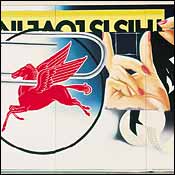
James Rosenquist is always being likened to a billboard painter. Not only did he once support himself painting billboards, but he makes art that draws upon their color, scale, iconography, and compositional pow! What’s misleading about the comparison is that Rosenquist’s painting also does exactly what a billboard doesn’t. A good commercial sign—whatever its dalliance with our subconscious desires—delivers a clear message. By contrast, Rosenquist is a natural surrealist. He creates half-hidden narratives, startling juxtapositions, and apocalyptic dreams. His art may seem to shout, but it also whispers. It may look lipstick-bright, but it also darkens in the eye. The explosion of pop culture over the American landscape—that boisterous, propulsive sprawl—may be an obvious inspiration. But Rosenquist does not stop there. He is a complicator of Pop.
James Rosenquist: A Retrospective, which opened last week at the Guggenheim and was organized by Walter Hopps and Sarah Bancroft, contains nearly 200 works. Most of the museum is filled with the artist’s large paintings, plus working collages and several room-size works. Although this outsize retrospective includes too many weak images—Rosenquist has a galactic strain in his sensibility that sometimes results in pictures that resemble corny sci-fi illustration—the Guggenheim is an ideal showcase for his art. As viewers circle around the ramp, the noble spiral becomes a twisting kaleidoscope offering a churning, ever-changing perspective. A viewer should stop to study individual paintings, of course, but it’s also appropriate—as with sculpture—to see the work on the move. Rosenquist’s art is already a collage of glimpses. Creating an ever-shifting succession of views enhances the impact of the whole.
The centerpiece of Rosenquist’s art is the famous F-111, a work made in 1964–65 that fills four sides of a room. F-111 is essentially a giant collage in which pieces of imagery collide, merge, move, and make visual rhymes with one another across the walls. Parts of the fighter-bomber—its stainless-steel fuselage and pointed nose—pass through other seemingly incongruous bits of imagery, such as a diver plunging underwater, a mass of spaghetti, an umbrella over a nuclear mushroom cloud, and a magazine illustration of a girl having her hair done. F-111 is usually described as an antiwar picture, a contemporary-history painting that depicts America during the Vietnam War. No doubt that’s true, but F-111 is less interesting as a didactic painting than as an evocation of the flicker of modern consciousness—whether now or in the Vietnam era. While watching television for a few minutes, you could well see an image of a nuclear explosion, an ad for canned spaghetti, a picture of a cute little girl, and a fighter plane. What flotsam does this send floating through the mind, just below the surface? Is the glistening of spaghetti in an ad related to the gleam of stainless steel on a fighter jet? Are such connections forever being made and unmade? We do not live all our time in such a condition, of course. But isn’t it amazing that we have evolved into amphibians who spend so much of our lives in these image streams?
American pop culture from the fifties and sixties now looks almost quaint: more Peggy Lee than J.Lo. It seems smaller, fuzzier, and less shiny than what’s produced today. Rosenquist’s paintings from the F-111 period can be surprisingly subtle visually—incorporating delicate pastels, for example, that wouldn’t be used in a real billboard—but retain that aura of a smaller, franker, clumsier, more naïve America. His later art, in turn, reflects the slick-as-a-dollar pizzazz and ballooning scale of contemporary pop narcissism. Just as he did with his earlier work, however, Rosenquist takes what the commercial culture provides—and then complicates it. He is creating increasingly abstract paintings whose subject appears to be light itself, a vortex of light that seems made from mirrors, lasers, the stars in Hollywood, and the stars above. Whatever it touches, this light reshapes and obscures.
The world grows ever bigger but ever more elusive.
Solomon R. Guggenheim Museum, 1071 Fifth Ave., at 88th St.; 212-423-3500. 10/17 through 1/25/04.